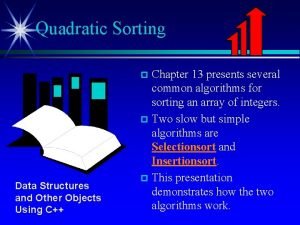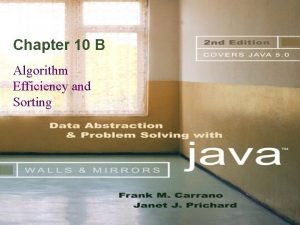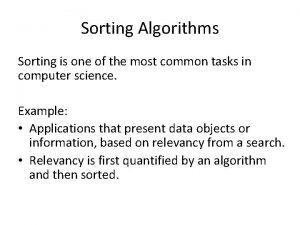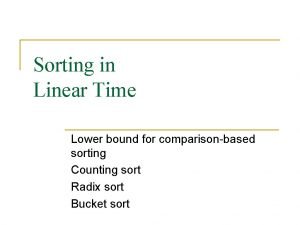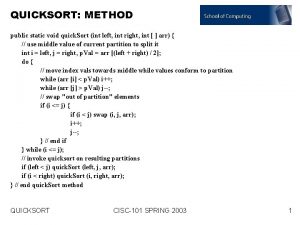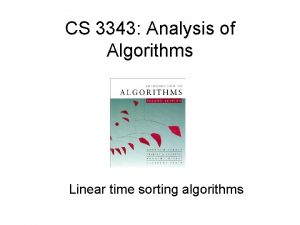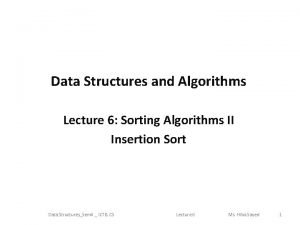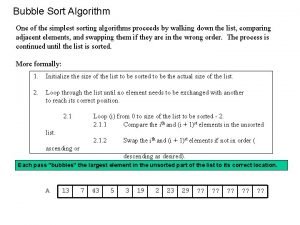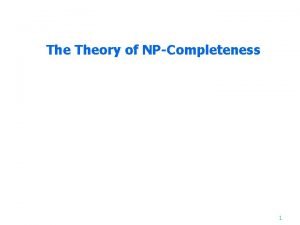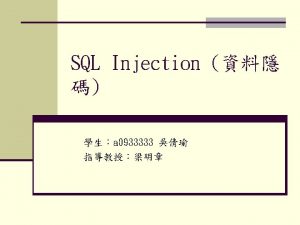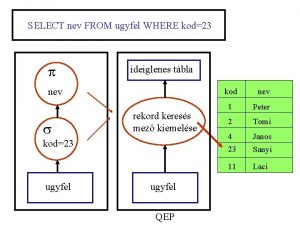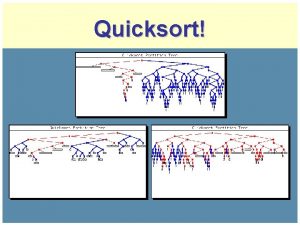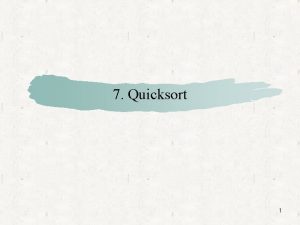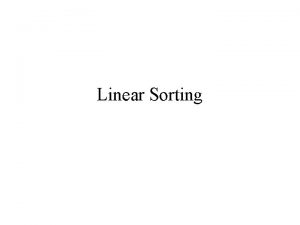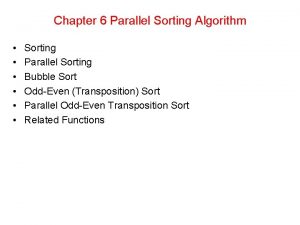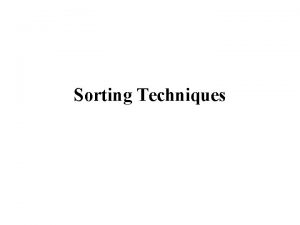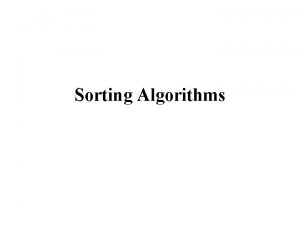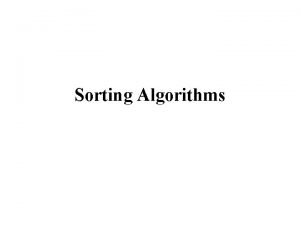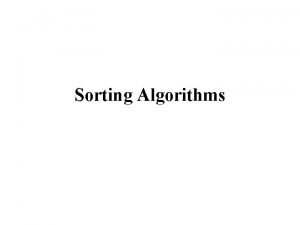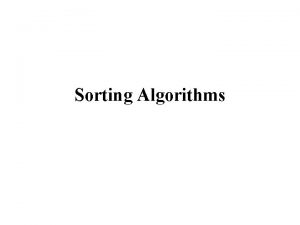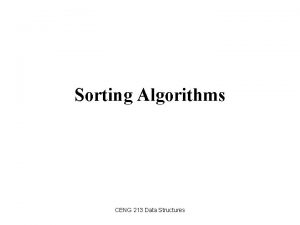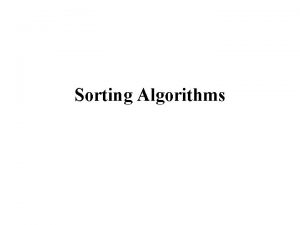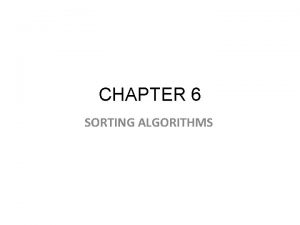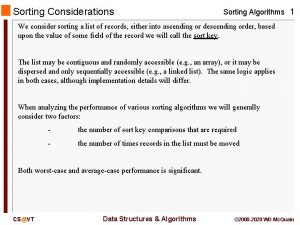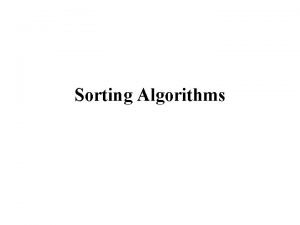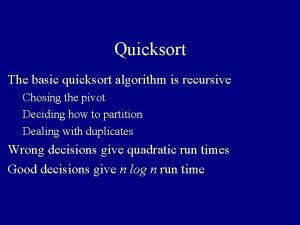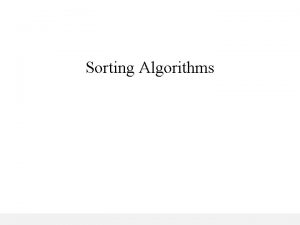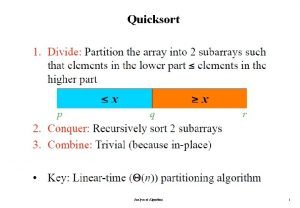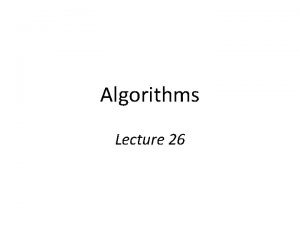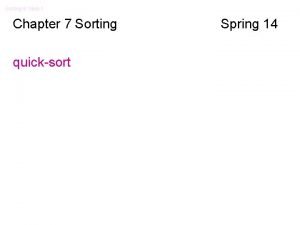Sorting Algorithms 2 Quicksort General Quicksort Algorithm Select






![Complexity of Quicksort Recurrence Relation: [Average Case] 2 sub problems ½ size (if good Complexity of Quicksort Recurrence Relation: [Average Case] 2 sub problems ½ size (if good](https://slidetodoc.com/presentation_image/355b37ab97cfc6c7d30c5eb8ac198339/image-7.jpg)
![Complexity of Quicksort Recurrence Relation: [Worst Case] Partition separates into (n-1) and (1) n Complexity of Quicksort Recurrence Relation: [Worst Case] Partition separates into (n-1) and (1) n](https://slidetodoc.com/presentation_image/355b37ab97cfc6c7d30c5eb8ac198339/image-8.jpg)








![Merge. Sort Example Temp Array 3 20 Array 18 Temp[i] < Temp[j] No 3 Merge. Sort Example Temp Array 3 20 Array 18 Temp[i] < Temp[j] No 3](https://slidetodoc.com/presentation_image/355b37ab97cfc6c7d30c5eb8ac198339/image-17.jpg)






![How Fast? [1, 2, 3] K 1 <= K 2 Yes [1, 2, 3] How Fast? [1, 2, 3] K 1 <= K 2 Yes [1, 2, 3]](https://slidetodoc.com/presentation_image/355b37ab97cfc6c7d30c5eb8ac198339/image-24.jpg)


- Slides: 26

Sorting Algorithms 2

Quicksort General Quicksort Algorithm: Select an element from the array to be the pivot n Rearrange the elements of the array into a left and right subarray n n All values in the left subarray are < pivot n All values in the right subarray are > pivot Independently sort the subarrays n No merging required, as left and right are independent problems [ Parallelism? !? ] n

Quicksort void quicksort(int* array. Of. Ints, int first, int last) { int pivot; if (first < last) { pivot = partition(array. Of. Ints, first, last); quicksort(array. Of. Ints, first, pivot-1); quicksort(array. Of. Ints, pivot+1, last); } }

Quicksort int partition(int* array. Of. Ints, int first, int last) { int temp; int p = first; // set pivot = first index for (int k = first+1; k <= last; k++) // for every other indx { if (array. Of. Ints[k] <= array. Of. Ints[first]) // if data is smaller { p = p + 1; // update final pivot location swap(array. Of. Ints[k], array. Of. Ints[p]); } } swap(array. Of. Ints[p], array. Of. Ints[first]); return p; }

Partition Step Through 9 18 9 5 3 5 partition(cards, 0, 4) P=0 K=1 cards[1] < cards[0] ? No P=0 K=2 cards[2] < cards[0] ? Yes P=1 temp = cards[2] = cards[1] = temp 5 18 3 9 3 20 18 20 P=1 K=3 cards[3] < cards[0]? Yes P=2 temp = cards[3] = cards[2] = cards[3] P=2 K=4 cards[4] < cards[0]? No temp = cards[2], cards[2] = cards[first] = temp, return p = 2;

Complexity of Quicksort Worst case is O(n 2) n What does worst case correspond to? n n Already sorted or near sorted n Partitioning leaves heavily unbalanced n subarrays On average is O(n log 2 n), and it is average a lot of the time.
![Complexity of Quicksort Recurrence Relation Average Case 2 sub problems ½ size if good Complexity of Quicksort Recurrence Relation: [Average Case] 2 sub problems ½ size (if good](https://slidetodoc.com/presentation_image/355b37ab97cfc6c7d30c5eb8ac198339/image-7.jpg)
Complexity of Quicksort Recurrence Relation: [Average Case] 2 sub problems ½ size (if good pivot) Partition is O(n) a=2 b=2 k=1 2 = 21 Master Theorem: O(nlog 2 n)
![Complexity of Quicksort Recurrence Relation Worst Case Partition separates into n1 and 1 n Complexity of Quicksort Recurrence Relation: [Worst Case] Partition separates into (n-1) and (1) n](https://slidetodoc.com/presentation_image/355b37ab97cfc6c7d30c5eb8ac198339/image-8.jpg)
Complexity of Quicksort Recurrence Relation: [Worst Case] Partition separates into (n-1) and (1) n Can’t use master theorem: n b (subproblem size) changes n-1/n n-2/n-1 n-3/n-2 n Note that sum of partition work: n + (n-1) + (n-2) + (n-3) … Sum(1, N) = N(N+1)/2 = O(N 2)

Complexity of Quicksort Requires stack space to implement recursion n Worst case: O(n) stack space n n n If pivot breaks into 1 element and n-1 element subarrays Average case: O(log n) n Pivot splits evenly

Merge. Sort n General Mergesort Algorithm: n n n Recursively split subarrays in half Merge sorted subarrays Splitting is first in recursive call, so continues until have one item subarrays n n One item subarrays are by definition sorted Merge recombines subarrays so result is sorted n n n 1+1 item subarrays => 2 item subarrays 2+2 item subarrays => 4 item subarrays Use fact that subarrays are sorted to simplify merge algorithm

Merge. Sort void mergesort(int* array, int* temp. Array, int low, int high, int size) { if (low < high) { int middle = (low + high) / 2; mergesort(array, temp. Array, low, middle, size); mergesort(array, temp. Array, middle+1, high, size); merge(array, temp. Array, low, middle, high, size); } }

Merge. Sort void merge(int* array, int* temp. Array, int low, int middle, int high, int size) { int i, j, k; for (i = low; i <= high; i++) { temp. Array[i] = array[i]; } // copy into temp array i = low; j = middle+1; k = low; while ((i <= middle) && (j <= high)) { if (temp. Array[i] <= temp. Array[j]) array[k++] = temp. Array[i++]; else array[k++] = temp. Array[j++]; } while (i <= middle) array[k++] = temp. Array[i++]; } // merge // if lhs item is smaller // put in final array, increment // final array position, lhs index // else put rhs item in final array // increment final array position // rhs index // one of the two will run out // copy the rest of the data // only need to copy if in lhs array // rhs array already in right place

Merge. Sort Example 20 3 18 9 5 Recursively Split 20 3 18

Merge. Sort Example 20 3 18 9 5 Recursively Split 20 3 9 18 5

Merge. Sort Example 20 3 18 Merge 9 5

Merge Sort Example 20 3 2 cards Not very interesting Think of as swap 3 20 Temp Array 3 20 Array 18 Temp[i] < Temp[j] Yes i j 3 k
![Merge Sort Example Temp Array 3 20 Array 18 Tempi Tempj No 3 Merge. Sort Example Temp Array 3 20 Array 18 Temp[i] < Temp[j] No 3](https://slidetodoc.com/presentation_image/355b37ab97cfc6c7d30c5eb8ac198339/image-17.jpg)
Merge. Sort Example Temp Array 3 20 Array 18 Temp[i] < Temp[j] No 3 j i k Update J, K by 1 => Hit Limit of Internal While Loop, as J > High Now Copy until I > Middle Array 3 18 18 20 k

Merge. Sort Example 9 3 Final after merging above sets i=0, j=3 2 Card Swap 5 18 20 3 5 i=1, j=3 i=1, j=4 5 9 i=1, j=5 9 18 20 i=2, j=5 i=3, j=5

Complexity of Merge. Sort Recurrence relation: 2 subproblems ½ size Merging is O(n) for any subproblem Always moving forwards in the array a=2 b=2 k=1 2 = 21 Master Theorem: O(n log 2 n) Always O(n log 2 n) in both average and worst case Doesn’t rely on quality of pivot choice

Space Complexity of Mergesort Need an additional O(n) temporary array n Number of recursive calls: n n Always O(log 2 n)

Tradeoffs n When it is more useful to: Just search n Quicksort or Mergesort and search n Assume Z searches Search on random data: Z * O(n) Fast Sort and binary search: O(nlog 2 n) + Z *log 2 n n

Tradeoffs Z * n <= nlog 2 n + Zlog 2 n Z(n - log 2 n) <= n log 2 n Z <= (n log 2 n) / (n-log 2 n) Z <= (n log 2 n) / n [Approximation] Z <= log 2 n [Approximation] Where as before, had to do N searches to make up for cost of sorting, now only do log 2 N 1, 000 items = 19 searches, instead of 1, 000

How Fast? n Without specific details of what sorting, O(n log 2 n) is the maximum speed sort possible. n n Only available operations: Compare, Swap Proof: Decision Tree – describes how sort operates Every vertex represents a comparison, every branch a result n Moving down tree – Tracing a possible run through the algorithm n
![How Fast 1 2 3 K 1 K 2 Yes 1 2 3 How Fast? [1, 2, 3] K 1 <= K 2 Yes [1, 2, 3]](https://slidetodoc.com/presentation_image/355b37ab97cfc6c7d30c5eb8ac198339/image-24.jpg)
How Fast? [1, 2, 3] K 1 <= K 2 Yes [1, 2, 3] No K 2 <= K 3 Yes K 1 <= K 3 Yes No [1, 2, 3] [2, 1, 3] stop K 1 <= K 3 Yes stop [1, 3, 2] No [2, 3, 1] stop K 2 <= K 3 Yes No stop [3, 1, 2] [2, 1, 3] stop [2, 3, 1] No stop [3, 2, 1]

How Fast? There are n! possible “stop” nodes – effectively all permutations of the n numbers in the array. n Thus any decision tree representing a sorting algorithm must have n! leaves n n The height of a this type of tree (a binary tree) is correlated with number of leaves: Height k = 2^(k-1) leaves n Must be at least log 2 n! + 1 height n

How Fast? n n Path from top to bottom of tree – trace of a run of the algorithm Need to prove that (log 2 n!) is lower bounded by (n log 2 n) n! = (n)(n-1)(n-2)(n-3) … (3)(2)(1) > (n)(n-1)(n-2)(n-3) … ceil(n/2) // doing fewer multiplies > ceil(n/2) (ciel(n/2)) // doing multiplies of bigger things > approximately (n/2) log 2 n! > log 2 (n/2) log 2 n! > (n/2) log 2 (n/2) //exponentiation in logs = multiplication out front log 2 n! > (n/2)(log 2 n – log 2 2) // division in logs = subtraction log 2 n! > (n/2)(log 2 n – 1) log 2 n! > (n/2)(log 2 n) – (n/2) log 2 n! > (1/2) [nlog 2 n – n] log 2 n! ~ O(n log 2 n)
 Difference between external and internal sorting
Difference between external and internal sorting Clhelse
Clhelse Quadratic sorting algorithms
Quadratic sorting algorithms Efficiency of sorting algorithms
Efficiency of sorting algorithms Sorting algorithms in c
Sorting algorithms in c N log n vs n
N log n vs n 10 sorting algorithms
10 sorting algorithms Bsort
Bsort External sorting algorithms
External sorting algorithms Most common sorting algorithms
Most common sorting algorithms Introduction to sorting algorithms
Introduction to sorting algorithms Insertion sort decision tree 4 elements
Insertion sort decision tree 4 elements Trace quicksort algorithm
Trace quicksort algorithm Algorithms for select and join operations
Algorithms for select and join operations Stable sorting algorithm
Stable sorting algorithm Sorting algorithm
Sorting algorithm Bubble sort trace table
Bubble sort trace table Cruken
Cruken Slowest sorting algorithm
Slowest sorting algorithm Non deterministic algorithm for sorting
Non deterministic algorithm for sorting Non deterministic algorithm for sorting
Non deterministic algorithm for sorting Quicksort
Quicksort Depth sorting algorithm
Depth sorting algorithm Select * from select
Select * from select Select * from select
Select * from select Select * from select
Select * from select Select * from select
Select * from select


